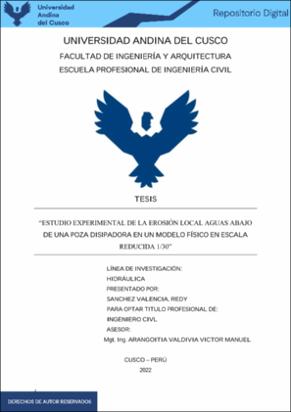| dc.contributor.advisor | Arangoitia Valdivia, Víctor Manuel | |
| dc.contributor.author | Sánchez Valencia, Redy | |
| dc.date.accessioned | 2023-01-04T14:44:14Z | |
| dc.date.available | 2023-01-04T14:44:14Z | |
| dc.date.issued | 2022-10-06 | |
| dc.identifier.uri | https://hdl.handle.net/20.500.12557/5134 | |
| dc.description.abstract | El propósito de esta investigación es evaluar la erosión local, aguas abajo de poza disipadora
en un modelo físico a escala reducida 1/30, con la finalidad es estudiar la erosión local, mediante
estudios experimentales se construyó un modelo físico, para tal fin se realizó 6 ensayos con los
siguientes caudales 29.54 l/s, 63.39 l/s, 105.34 l/s, 148.23 l/s, 189.56 l/s y 232.65 l/s, Se
consideró un nivel aguas arriba constante de 0.32 m y los siguientes niveles aguas debajo de
0.049 m, 0.084, 0.121 m, 0.115 m, 0.182 m y 0.219 m respectivamente, con aberturas de
compuertas promedio de 0.011 m, 0.0256 m, 0.0451 m, 0.0681 m, 0.094 m y 0.128 m
respectivamente; Los ensayos se realizaron bajo las condiciones de un flujo subcrítico,
manteniendo un numero de Froude ente 0.017 a 0.453, y Reynolds entre 6895.043 a 202540.5,
considerando como un flujo supercrítico, para los ensayos se empleó un canal de sección
rectangular de 13.00 m de largo, 1.90 m de ancho y 1.90 m de altura, con una pendiente de
0.0008m/m; para las mediciones de velocidad del flujo se usó el Acoustic Dopler Velocimeter
(ADV); para evaluar la erosión, se consideró un lecho compactado con arena cuasi uniforme
con d50= 0.24 mm y módulo de fineza de 2.16 para cada ensayo.
Como resultados de la investigación se determinó la erosión máxima para los 6 ensayos, en 8
h, 10 h, 10 h, 8 h, 10 h y 10 horas respectivamente, y la erosión observada son 0.023 m, 0.073
m, 0.110 m, 0.166 m, 0.209 m y 0.244 m m respectivamente, también se demostró que la erosión
en función del tiempo crece logarítmicamente en los 5 últimos ensayos, mas no se cumple lo
mismo en el ensayo correspondiente al caudal 29.54 l/s. En cuanto a los perfiles de velocidad,
no se asemejan a ninguno de perfiles encontrados por Nik Hassan y Rangaswami Narayanan
quien investigo un caso similar en donde evaluaron los perfiles de velocidad. | es_PE |
| dc.description.abstract | The purpose of this research is to evaluate the local erosion, downstream of the dissipating pool
in a physical model at a reduced scale of 1/30, with the purpose of studying local erosion,
through experimental studies a physical model was built, for this purpose a 6 tests with the
following flows 29.54 l/s, 63.39 l/s, 105.34 l/s, 148.23 l/s, 189.56 l/s and 232.65 l/s, a constant
upstream level of 0.32 m and the following downstream levels were considered of 0.049 m,
0.084, 0.121 m, 0.115 m, 0.182 m and 0.219 m respectively, with average gate openings of
0.011 m, 0.0256 m, 0.0451 m, 0.0681 m, 0.094 m and 0.128 m respectively; The tests were
carried out under the conditions of a subcritical flow, maintaining a Froude number between
0.017 to 0.453, and a Reynolds number between 6895.043 and 202540.5, considering it as a
supercritical flow, for the tests a channel with a rectangular section of 13.00 m long was used.
, 1.90 m wide and 1.90 m high, with a slope of 0.0008m/m; for flow velocity measurements,
the Acoustic Dopler Velocimeter (ADV) was used; To evaluate erosion, a compacted bed with
quasi-uniform sand with d50= 0.24 mm and a fineness modulus of 2.16 was considered for each
test.
As results of the investigation, the maximum erosion was determined for the 6 tests, at 8 h, 10
h, 10 h, 8 h, 10 h and 10 hours respectively, and the observed erosion is 0.023 m, 0.073 m,
0.110 m, 0.166 m , 0.209 m and 0.244 mm respectively, it was also shown that the erosion as a
function of time grows logarithmically in the last 5 tests, but the same is not true in the test
corresponding to the flow rate of 29.54 l/s. Regarding the speed profiles, they do not resemble
any of the profiles found by Nik Hassan and Rangaswami Narayanan who investigated a similar
case where they evaluated the speed profiles. | en_US |
| dc.format | application/pdf | es_PE |
| dc.language.iso | spa | es_PE |
| dc.publisher | Universidad Andina del Cusco | es_PE |
| dc.rights | info:eu-repo/semantics/openAccess | es_PE |
| dc.rights.uri | https://creativecommons.org/licenses/by-nc-nd/4.0/ | es_PE |
| dc.subject | Perfiles de velocidad | es_PE |
| dc.subject | Flujo subcrítico | es_PE |
| dc.subject | Erosión local | es_PE |
| dc.title | Estudio experimental de la erosión local aguas abajo de una poza disipadora en un modelo físico en escala reducida 1/30” | es_PE |
| dc.type | info:eu-repo/semantics/bachelorThesis | es_PE |
| thesis.degree.name | Ingeniero Civil | es_PE |
| thesis.degree.grantor | Universidad Andina del Cusco. Facultad de Ingeniería y Arquitectura | es_PE |
| thesis.degree.discipline | Ingeniería Civil | es_PE |
| dc.publisher.country | PE | es_PE |
| dc.subject.ocde | https://purl.org/pe-repo/ocde/ford#2.01.00 | es_PE |
| renati.advisor.dni | 23806451 | |
| renati.advisor.orcid | https://orcid.org/0000-0002-5306-5460 | es_PE |
| renati.author.dni | 48255413 | |
| renati.discipline | 732016 | es_PE |
| renati.juror | Somocurcio Alarcón, Héctor Erick | |
| renati.juror | Mosqueira Lovon, Carlos Alberto | |
| renati.juror | Luna Loayza, Carlos | |
| renati.juror | Machicao Olivera, Percy | |
| renati.level | https://purl.org/pe-repo/renati/level#tituloProfesional | es_PE |
| renati.type | https://purl.org/pe-repo/renati/type#tesis | es_PE |
| dc.description.lineadeinvestigacion | Hidráulica | es_PE |


